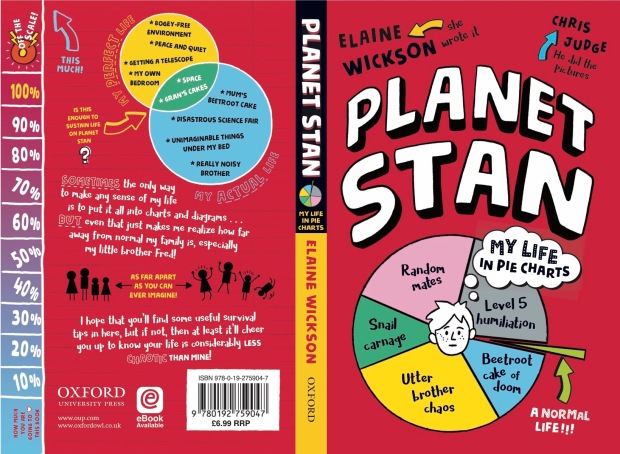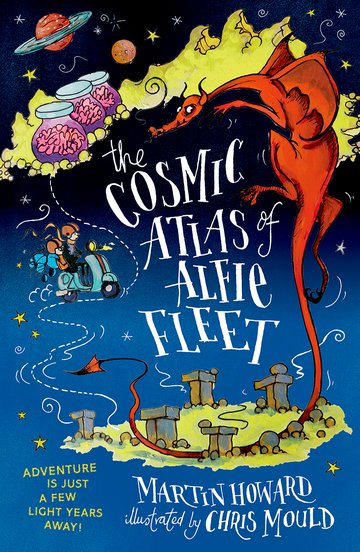
‘A fantastic fusion of the time travelling of Adams, the humour of Pratchett and the eccentricities of Stanton. Outlandishly good… this is imagination at its pure and absolute wildest!‘
Rating: ⭐⭐⭐⭐⭐
Title: The Cosmic Atlas of Alfie Fleet
Author: Martin Howard (@MJHowardWrites)
Illustrator: Chris Mould (@chrismouldink)
Publisher: Oxford University Press Children’s (@OUPChildrens)
Page count: 336
Date of publication: 7th March 2019
Series status: N/A
ISBN: 978-0192767509
Perfect for Year 4, Year 5 and Year 6.
#3Words3Emojis:
1. Cosmos 🌌
2. Atlas 🗺️
3. Brains-in-Jars 🧠
Bored of the same old routine?
Longing for a bit of adventure in your life?
Love living life on the edge?
Then join Alfie Fleet and discover a whole universe of wonders (and things that are not so wonderful too, but we won’t go into that now).
From giant sand lobsters on planet Maureen and the Twang Bears of Mumsy, to the eerie (yet oddly quite boring) brains in jars on Brains-in-Jars World – there’s something for everyone. And if danger’s your thing you won’t want to miss Outlandish, with its gold-hoarding dragon, take-your-life-in-your-hands cuisine, and welcoming locals who’ll fire lightning bolts at you.
Thrills and adventure await, just hop on board the slightly old and rusty moped of infinity!
Review: After desperately needing some money and thinking that he’s in luck, Alfie Fleet (a poor, destitute young boy who lives with his mother in a ramshackle, run-down house) responds to an advert in the newspaper where he thinks he can make the extra £49.99 to add to his £100 to make his mother’s dreams come true to buy her the most wonderful of birthday presents: the Sole Sensation 6000 Foot Spa.
However (and it’s a common theme in this book), Alfie’s best-laid plans go slightly awry in meeting the man who he thinks will bestow him with this most needed of money. Meeting a professor might be a transformative experience for many but for Alfie it’s life-changing. Especially one who goes by the rather amusing name of Professor Bowell-Mouvemont and mark my words, there’s plenty more amusing names to come!
Taking Alfie on a tour where he experiences new dimensions, new worlds and new characters and creates a world for this book of its very own as Martin’s mind comes to life on these very pages through the incredible, inter-cosmological and inimitable illustrations of Chris Mould. As the professor reveals (rather hysterically!) that these new lands are often unmapped and undocumented, Alfie begins to articulate his adventures through his own version of the Cosmic Atlas. If you think you’ve seen one travel guide then you’ve seen them all, well think again because this ranges from the surreal to the sublime and will be a source of inspiration for its readers to create peculiar places of their own.
But as the Professor and Alfie are soon left to discover for themselves, the way back home may not be as simple as it first seemed. Can they return to give Alfie’s mum the present he thinks she’s always wanted or will they be trapped in this weird and wonderful world…?
It’s more than science-fiction or science-fantasy with every page taking you in a different direction and this is what makes it truly unique. Wacky, insanely inventive and heaps of fun, I can completely guarantee that this book will be lapped up by children (and adults!) who love laughing out loud due to its fantastic fusion of the time-travelling of Adams, the humour of Pratchett and the eccentricities of Stanton.
Forget the boundaries of space, forget the boundaries of time and forget the boundaries of imagination because this is outlandishly good. This is imagination at its pure and absolute wildest!
A fantastic fusion of the time travelling of Adams, the humour of Pratchett and the eccentricities of Stanton. Outlandishly good… this is imagination at its pure and absolute wildest!‘
What’s It All About, Eh?
If you are interested in the universe or anything in it then The Cosmic Atlas of Alfie Fleet is the book for you. Not only is it a proper science-fiction, fantasy, travel guide adventure, but it answers questions that have left science scratching its chin. Who could ask for more? As a taste of the surprises that await, The Reader Teachercan reveal just a few of those secrets. Glue your eyeballs to this screen for just a sample of that astonishing knowledge …
How Did Human Life on Earth Begin?
Let’s start with the BIG question. Some books tell you it all began with monkeys. Wrong! The Cosmic Atlas of Alfie Fleetteaches us that stone circles brought humans to Earth. Yes, stone circles. You know, like Stonehenge. This is how it happened …
About a million years ago, a man named Partley Mildew invented stone circles on the planet Wip-Bop-a-Looma, starting a craze for inter-galactic travel. His circles had the power to send people across a bejillion miles of space in the blink of an eye, allowing humans to explore the universe. People loved them. Travelling to distant planets meant they could go swimming with Giggling MegaFish on planet Mip before breakfast then have lunch on the other side of the universe while their brains were spring-cleaned by friendly Limpation Cranium Toads. Soon, holiday companies were building bigger and bigger stone circles to cope with crowds of tourists. Across the universe, happy holiday-makers dipped their toes in the Sweat Sea on planet S’Panq, flapped across planet Win’span on homemade wings, or danced on Ominoss-Merkwerld, lit by swarms of multi-coloured discoflies.
Tourists first arrived on Earth about forty thousand years ago, and immediately described it as “delightful”. As the travel brochures said, “Comefor the fresh air, stayfor the mammoths.” Of course, these early tourists didn’t call the planet “Earth.” They called it “Toby”. Toby became a popular holiday destination, famous for its beaches and great restaurants. Some humans decided to make their home here, and also decided that Toby was a nice enough name for a boy but sounded silly on a planet. As there was a lot of earth on Toby, the planet’s new people took a vote and renamed their world “Earth.” Interestingly, the name “Chickens” came in second place.
Wow. Why Didn’t We Know About This?
As thousands more years went by tourism died off. Tobians, or “Earthlings” as they now called themselves, forgot they had cousins on other planets. They forgot what stone circles had been used for, too. “Hmm,’ historians thought to themselves. “These stone circles must have been important. Something to do with gods, I’ll bet.” It’s worth mentioning that if people don’t understand something, it’s often blamed on gods. Gods get quite cheesed off with this.
How Has this Incredible Secret Been Preserved?
Around the universe most folk had forgotten about the power of stone circles but one group remembered. They called their society the Unusual Cartography Club, and the members continued to travel the universe, mapping planets for their Cosmic Atlas: the finest collection of extra-terrestrial maps this side of Nerwong-Nerwong Plinky-Plonk.
That Sounds Like the Sort of Thing People Would Remember
Well, no. Not really. People forget important stuff all the time. Pyramids for example. If you think space travelling stone circles are weird, pyramids would reallyblow your mind. Plus, though the UCC wasn’t exactly a secretsociety its members got tired of people giving them funny looks. Try this simple experiment: next time you’re invited to a party, open a conversation by saying, “Hullo, I spent last week mapping planet Foopsie-Wigglefinger. They have pink ostriches with three bottoms there, you know.” Funny looks, right? And no more party invitations. After a while the UCC’s explorers just stopped talking about their adventures.
Interesting. Tell Me More About This Unusual Cartography Club
It’s a club with a long history. At first, its members used Stonehenge to get around. Around two thousand years ago though, bits started falling off the ancient circle. Instead of repairing it, the UCC’s President – Dogstinkle the Crispy, who suffered from a bad leg in damp weather – decided to build a smaller circle, indoors where he would be out of the rain. More years went by and a city grew up around the new UCC headquarters. Empty fields became Wigless Square. Dogstinkle’s mud hut was demolished and replaced many times, most recently with a large mansion, now surrounded by other houses and Mr Hong’s Happy Dragon takeaway. A cavern was dug beneath the house and the circle moved onto a rotating platform. Invented by Medelaine Tusk, it made spinning the heavy stones to new co-ordinates much, mucheasier than shifting them about by hand.
The UCC’s mission of mapping the universe went on but the club lost members. Some got eaten by ghastly tentacled things, or blown up by unexpected volcanoes. Others just wandered off on worlds they liked better. Eventually, only one member of the UCC remained at Number Four, Wigless Square; one man in all the world who knew the power of stone circles: Professor Pewsley Bowell-Mouvemont. But the old UCC headquarters on Wigless Square was about to be demolished and the UCC’s maps, treasures and secrets destroyed forever.
No! What a Waste!
Woah there. All is not lost. Luckily, the Professor had a bad back and needed help with some light lifting and carrying. Enter Alfie Fleet – a boy with a destiny. Thanks to Alfie’s amazing brain-power, the old Unusual Cartography Club is about to change forever. Oh, and the entire universe, too. Sounds like fun? Well, read on. The Cosmic Atlas of Alfie Fleetcontains further surprises about the universe, plus travel information about where to eat and stay on the planet of Outlandish, as well as stuff you did not know concerning elves, villainous scum hairdressers, Pulsating Swibs, and much, much more …
Enjoy! Or, as the Professor would say, “Who me? Ahh, what would I say? No, it’s gone. Forget my own … umm … thingy next. Something about prawns, was it?”
COMPETITION TIME: If you’re the kind of person who enjoys reading about strange planets and the weird people who live on them why not enter our competition? Design us a planet and Martin Howard and Chris Mould might help bring it to life so it can be included in book two of Alfie Fleet’s adventures! The winner’s planet will appear in the book and their name in the credits. They’ll also get a signed book, signed Chris Mould print of their planet and any other goodies we can lay our hands on. Probably chocolate. More details will be posted on Martin’s website soon: https://booksbymart.pub/
Big thanks to Martin, Emma and all the team at OUP Children’s for inviting me to share my thoughts as part of The Cosmic Atlas of Alfie Fleet blog tour and for sending me early copies of the proof and finished versions in exchange for an honest review.
Extra thanks to Martin for writing his fascinating guest post!
Mr E
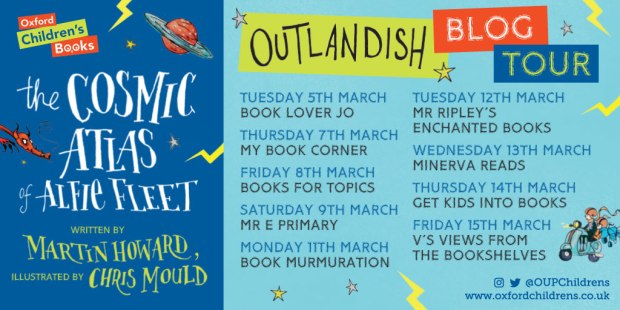
Be sure to check out the rest of The Cosmic Atlas of Alfie Fleet blog tour with exclusive guest posts and reviews from all of these brilliant book bloggers!


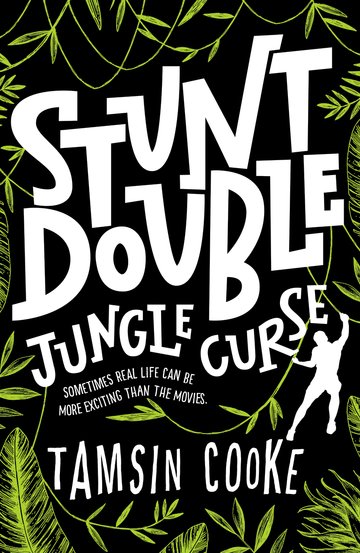
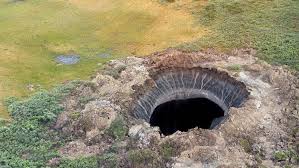 So I am a planner and I’m proud. And I think planning a book is like planning a stunt. You need to ensure there’s a set up, everyone’s in the right place at the right time, there’s dramatic tension, and there are no holes in the story – just like you don’t want any holes in your safety equipment!
So I am a planner and I’m proud. And I think planning a book is like planning a stunt. You need to ensure there’s a set up, everyone’s in the right place at the right time, there’s dramatic tension, and there are no holes in the story – just like you don’t want any holes in your safety equipment!









